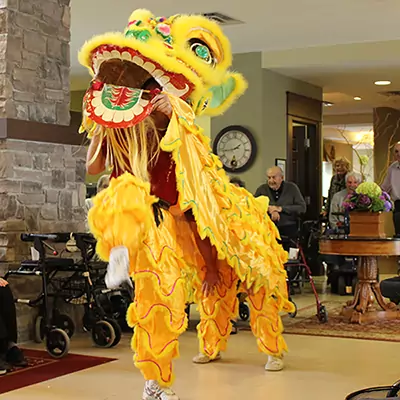Updated on June 28, 2022
History of Lion Dance

Lion Dance History & Folklore
Lion is considered in many fables as the "king of the jungle". Its body structure, with its mane, gives the physical appearance of majestic, proud stature. As the lion is a natural predator, it possesses the strength and power to hunt, protect its pride and drive away enemies. Like many cultures, the Chinese believe that the presence and aura of the lion are ominous. As the lion is considered a being sent down from heaven, its divinity, nobility, strength, courage and wisdom presence will drive away evil and bring good fortune. Lion dance tradition is deeply rooted in Chinese culture for over a thousand years. The dance is performed in various events to liven, increase the pomp of festivities, especially during festivals and celebrations. In Toronto, lion dance is very popular during the Chinese New Year seasons. There are no documented records on the origins of lion dance. There are several versions of the tale which have been passed down verbally from past generations to the present.
Lion Dance Mythology in China
The "Nian" tale:
Every spring before the Spring Festival, the beast called "Nian" attacked the village and destroy crops. Tired of the destruction, the villagers banded together and came up with a solution. They built a fierce-looking and brightly coloured costume with a mask that looked like a lion. When the Nian returned to terrorize the villagers again, they donned the costume and waved the mask towards the Nian. The prancing about in costume along with the loud noise of beating pots and pans was enough to frighten and drive the beast away and never to return again. Ever since, the event performance has been reenacted annually, on Lunar New Year, that symbolizes happiness, success, good fortune.
In some accounts of the story of the Nian, the beast was actually a lion which was eventually tamed by a Buddhist monk and became the guardian to the villagers. Some lion dances would have the Big-Headed Buddha (in Cantonese, it is called the Dai Tao Fut).
Good omen dream:
A Tang dynasty legend has it that the Emperor dreamt of an odd-looking creature, that he has never seen before, saving his life. Upon waking up, the emperor described to his advisors and asked them what was that creature he had in his dream. Since there were no lions in China, nobody had the answer except for one of his ministers. The minister told him that the creature was a lion. As the emperor felt his dream had messages of good omen, he ordered the construction of the model "lion".
Born again lion:
The mythical lion who lived in heaven has a fondness for practical jokes. One day the lion's behaviour angered the Jade Emperor. The Jade Emperor killed the lion and tossed out its detached head and body to rot. Feeling pity and merciful, Goddess Kwan Yin, the Goddess of Mercy, re-attached the lion's head and body with a red sash and give the lion life again on the condition that it will do acts of goodwill.
Today, the red sash is seen on the lion's head and it symbolizes positive life energy, Yang energy (Yin, which is negative energy, is the opposite of Yang).
Goddess Kwan Yin also attached in the front of the lion's forehead a unicorn horn and a reflective object i.e. mirror which are believed to bring good fortune and drive away evil spirits. (Unicorn is one of the celestial animals in Chinese folklore).